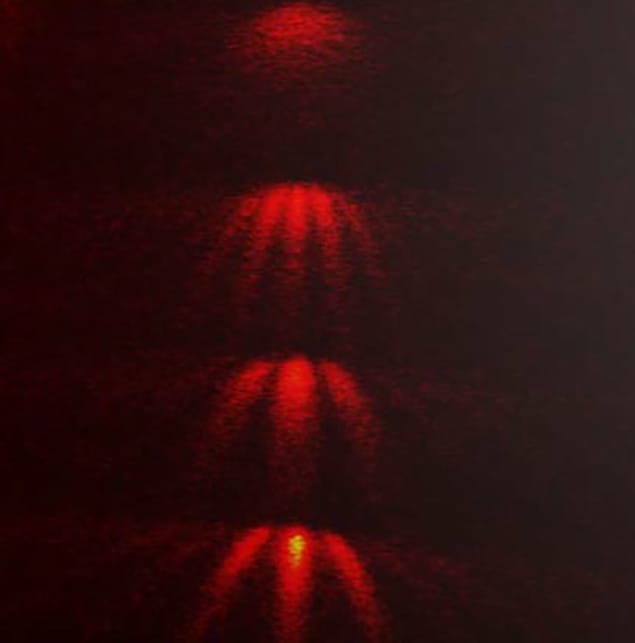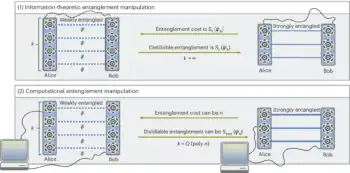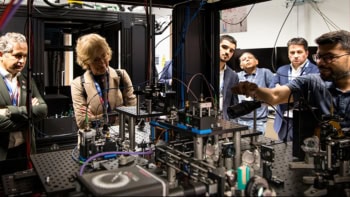
A group of physicists in Austria has directed a beam of large molecules at a series of extremely narrow slits to search for a phenomenon known as “multipath interference”. Although, as expected, they found nothing, they say that the search is well worth the effort given the potential prize on offer – disproving the principle of superposition and with it quantum mechanics as we know it.
According to the superposition principle, any two quantum states can always be added together to create a third, valid state. Conversely, it is always possible to split an existing quantum state into two sub-states. The latter characteristic is exploited in many quantum technologies, be it the superposition of a 0 and a 1 in a quantum bit or the splitting and interference of a laser beam to measure tiny variations in position or acceleration.
To investigate whether superposition really occurs in nature, the latest research relies on a particular characteristic of a quantum object: that no matter how many paths it could take to go from one state to another, the mathematical expression describing the probability of it yielding a certain measured outcome can always be split into a series of terms, each of which involves the object following no more than two paths at the same time. The existence of irreducible three- or more-path interference would require the (linear) Schrödinger equation to be replaced by a more general, nonlinear alternative.
Massive particles
Other groups have recently looked for evidence of this multipath interference using, among other things, beams of laser light and microwaves. But the new work, carried out by Joseph Cotter of the University of Vienna in Austria and colleagues, is the first to have done so using massive particles. As Cotter explains, the existence of a mass-dependent term in a nonlinear extension to the Schrödinger equation might explain why quantum effects disappear at macroscopic scales.
In its study, the team considers what happens when a beam of massive particles passes through a set of three slits. Thanks to wave-particle duality, the beam will generate a set of interference fringes on a screen placed some distance behind the slits. This pattern will be formed even when only one particle passes through the slits at any one time. If superposition holds true, the wave function describing the beam passing through all three slits will be equal to the sum of the wave functions associated with each individual slit.
In this case, with a total of three slits, the probability of a particle arriving at any point on the screen can be written in terms of six sub-probabilities – three of which specify the odds associated with the particle passing through just each single slit and the other three the chances linked to it instead passing through a given pair of slits. This means superposition can be tested by comparing the probabilities measured in a three-slit experiment with those obtained in one- and two-slit experiments: if the appropriate combination of results from the latter do not match the result of the former then the Schrödinger equation has been found wanting.
Simultaneous patterns
The group used a laser to generate a thermal beam comprising molecules of a dye known as phthalocyanine that they directed at a diffraction mask made by scientists in Israel. The mask contained slits just 80 nm wide arranged into four groups – a single slit, two double slits and a triple slit – that yield simultaneous interference patterns on a screen positioned behind.
The researchers found, as Schrödinger’s equation dictates, that by subtracting the suitably summed intensities of the single and double slits from that of the triple slit they were left with intensities very close to zero. In fact, they observed that the position of less than one particle in every 100 recorded on the screen was at odds with the predictions of quantum mechanics. This result held true for particles across the width of the diffraction pattern and for the full range (2.5–5 pm) of De Broglie wavelengths tested.
Angelo Bassi of the University of Trieste in Italy praises the “novel” experiment, describing it as “further confirmation that quantum mechanics holds true at a higher level than can be explored using ‘standard’ double-slit experiments”. The eventual discovery of multipath interference, according to Raymond Laflamme of the University of Waterloo in Canada, would lead to a “revolution in our understanding of the world”. Indeed, he maintains, “trying to find where quantum mechanics would fail is as interesting as trying to build quantum computers.”
Lighter and heavier
Carrying out more sensitive probes of multipath interference using massive particles could potentially be done in a couple of different ways, says Cotter. One is to replace the relatively heavy, thermal – and therefore short-wavelength – molecules used in the current experiment with cold, low-mass atoms such as helium or lithium with longer wavelengths. This is because if multipath interference occurs, it is expected to scale as the 3/2 power of wavelength. However, if mass does modify the Schrödinger equation, then more massive particles could be tried. Doing so, says Cotter, would require brighter molecular sources to up the rate of data-taking as well as more advanced masks, perhaps created optically.
The research is described in Science Advances.



